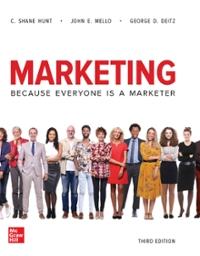Question
Procter & Gamble (P&G) is the world's leading manufacturer of consumer products. P&G, founded in 1837 by British American William Procter and Irish American James
Procter & Gamble (P&G) is the world's leading manufacturer of consumer products. P&G, founded
in 1837 by British American William Procter and Irish American James Gamble, is headquartered
in Cincinnati in the United States, and the company has now been built into a $65 billion
conglomerate. Within its portfolio, P&G has 21 billion-dollar brands (e.g., Bounty, Crest, Tide),
operates 130 plants staffed by 95,000 people, has some 70,000 suppliers around the world, and sells
its products in more than 180 countries. By all accounts, P&G has been a giant multinational
corporation for more than a century and will continue to be highly influential in consumer products
for years to come.
At the same time, very few industries are as competitive as consumer packaged goods. Just think
about the options that you now have compared with five years ago. In most cases, we as customers
have numerous more options in every consumer packaged-goods category than we did then. The
global marketplace has a lot to do with this competitive environment. Fragmentation and
specialization in consumer products from more companies have resulted in more products and more
places from which to buy. The infrastructure for developing products, entering markets, and
maintaining customer relationships is more robust than ever, resulting in small- and medium-sized
enterprises (SMEs) being competitive with companies like P&G (which they could not have
competed with just a few years ago).
This market competitiveness has led companies like P&G to constantly assess the efficiencies
and effectiveness of their production, operations, and global supply chains. For a long-standing
industry titan like P&G, this increasingly competitive global environmentsee the figures in
Chapter 1 that show the drastically increased international trade in the last 20 yearshas led to a
newfound sense of urgency for P&G to get closer to both its customers and suppliers to maximize
diminishing margins while selling products at a competitive price. This is not an easy task since
margins in the consumer packaged goods market are already very tight. That led P&G to evaluate
and ultimately remake their global supply chains.
P&G's goal is to replenish at least 80 percent of the retail orders the company receives in less
than a day. To be able , P&G redesigned its distribution network. The company has
improved transparency throughout the end-to-end supply chain, developed even stronger
partnerships with its suppliers, and focused on maximizing synergy throughout the production
cycle. Given this focus on synergy and supplier partnerships, P&G now develops global strategic
supply chain plans jointly with (at least) its core suppliers. This is not to say that all 70,000
suppliers working with P&G are involved but the so-called "strategic suppliers" are very much
entrenched in working together with P&G.
P&G's 70,000 suppliers include chemical companies (e.g., Dow Chemicals, DuPont) that supply
raw materials for cleaning supplies; packaging companies (e.g., Diamond Packaging, VanGenechten Packaging) that supply packaging materials for the company's products; and Page 410
indirect spend providers (e.g., Jones Lang Lasalle) that deliver services such as
warehouse maintenance and janitorial services. With the number and breadth of suppliers, P&G
continuously focuses on maintaining a strong supplier relations program. Guiding its supplier
relations program, P&G has a set of core principles: (1) Best Total Value, (2) Honest, Ethical,
and Fair Dealings, (3) Externally Linked Supply Solutions, (4) Competition and Collaboration, and
(5) Supplier Incumbency.
P&G appears to be in the forefront of continually evaluating and, when needed, remaking its
global supply chains to maintain the titan position in the consumer packaged goods industry.
Despite this success at being able to remake itself so far, one can wonder if P&G, at some point,
will run into difficulties competing with companies like Alibaba and Amazon. Or, will Alibaba and
Amazon simply continue to sell P&G's products (instead of starting to market their own).
Alternatively, will companies like P&G be able to use their sophisticated global supply chains to
expand into new territories similar to what Alibaba and Amazon did not too long ago?
Question 1
What can P&G do to protect its brands from at attack by Amazon and Alibaba private-label products?
QUESTION 2: What should P&G do to move into the e-commerce space occupied by Amazon and Alibaba? Would you sell your P&G products on Amazon and Alibaba?
QUESTION 3: Logistics is a complex process. Major logistics systems include: inbound raw material sourcing; shipping products to intermediate locations (warehousing); shipping to the final customer (end user). Assume that P&Gs major products are included in HS code 34 and 96; and, assume that P&G is serious about one-day delivery to the final customer (household). What countries would you put a warehouse in to ensure that it can get to the final customer in one day?
Step by Step Solution
There are 3 Steps involved in it
Step: 1

Get Instant Access to Expert-Tailored Solutions
See step-by-step solutions with expert insights and AI powered tools for academic success
Step: 2

Step: 3

Ace Your Homework with AI
Get the answers you need in no time with our AI-driven, step-by-step assistance
Get Started


